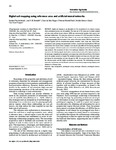Por favor, use este identificador para citar o enlazar este ítem:
http://www.alice.cnptia.embrapa.br/alice/handle/doc/1051574Registro completo de metadatos
| Campo DC | Valor | Lengua/Idioma |
|---|---|---|
| dc.contributor.author | ARRUDA, G. P. de | pt_BR |
| dc.contributor.author | DEMATTÊ, J. A. M. | pt_BR |
| dc.contributor.author | CHAGAS, C. da S. | pt_BR |
| dc.contributor.author | FIORIO, P. R. | pt_BR |
| dc.contributor.author | SOUZA, A. B. e. | pt_BR |
| dc.date.accessioned | 2016-08-24T11:11:11Z | pt_BR |
| dc.date.available | 2016-08-24T11:11:11Z | pt_BR |
| dc.date.created | 2016-08-24 | pt_BR |
| dc.date.issued | 2016 | pt_BR |
| dc.identifier.citation | Scientia Agricola, Piracicaba, v. 73, n. 3, p. 266-273, May/Jun. 2016. | pt_BR |
| dc.identifier.uri | http://www.alice.cnptia.embrapa.br/alice/handle/doc/1051574 | pt_BR |
| dc.description | Digital soil mapping is an alternative for the recognition of soil classes in areas where pedological surveys are not available. The main aim of this study was to obtain a digital soil map using artificial neural networks (ANN) and environmental variables that express soillandscape relationships. This study was carried out in an area of 11,072 ha located in the Barra Bonita municipality, state of São Paulo, Brazil. A soil survey was obtained from a reference area of approximately 500 ha located in the center of the area studied. With the mapping units identified together with the environmental variables elevation, slope, slope plan, slope profile, convergence index, geology and geomorphic surfaces, a supervised classification by ANN was implemented. The neural network simulator used was the Java NNS with the learning algorithm "back propagation." Reference points were collected for evaluating the performance of the digital map produced. The occurrence of soils in the landscape obtained in the reference area was observed in the following digital classification: medium-textured soils at the highest positions of the landscape, originating from sandstone, and clayey loam soils in the end thirds of the hillsides due to the greater presence of basalt. The variables elevation and slope were the most important factors for discriminating soil class through the ANN. An accuracy level of 82% between the reference points and the digital classification was observed. The methodology proposed allowed for a preliminary soil classification of an area not previously mapped using mapping units obtained in a reference area | pt_BR |
| dc.language.iso | eng | eng |
| dc.rights | openAccess | eng |
| dc.subject | Extrapolação de mapas | pt_BR |
| dc.subject | Pesquisa pedológica | pt_BR |
| dc.subject | Atributos da paisagem | pt_BR |
| dc.subject | Aulas pedológicas | pt_BR |
| dc.subject | Mineração de dados | pt_BR |
| dc.title | Digital soil mapping using reference area and artificial neural networks. | pt_BR |
| dc.type | Artigo de periódico | pt_BR |
| dc.date.updated | 2016-08-24T11:11:11Z | pt_BR |
| riaa.ainfo.id | 1051574 | pt_BR |
| riaa.ainfo.lastupdate | 2016-08-24 | pt_BR |
| dc.identifier.doi | 10.1590/0103-9016-2015-0131 | pt_BR |
| dc.contributor.institution | GUSTAVO PAIS DE ARRUDA, APagri Agronomic Consultancy; JOSÉ A. M. DEMATTÊ, USP/ESALQ; CESAR DA SILVA CHAGAS, CNPS; PETERSON RICARDO FIORIO, USP/ESALQ; ARNALDO BARROS E SOUZA, USP/ESALQ. | pt_BR |
| Aparece en las colecciones: | Artigo em periódico indexado (CNPS)  | |
Ficheros en este ítem:
| Fichero | Descripción | Tamaño | Formato | |
|---|---|---|---|---|
| 2016022.pdf | 1,82 MB | Adobe PDF |  Visualizar/Abrir |









